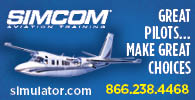As the year-end approaches, now is the time to make sure your logbooks and flight records are in order. Complete and accurate records will allow you to maximize aircraft-related deductions on your business or personal income tax return.
The key principal to keep in mind when documenting the business use of your aircraft is, “the more the better.” Although the use of private aircraft in furtherance of business has been a common business practice for many years, private aircraft remain under increased scrutiny.
Unfortunately, the person oftentimes scrutinizing your records, the “doubtful” revenue agent, has a preconceived notion that private aircraft are not truly useful business tools, especially with the availability of commercial flights. Some even believe that private aircraft are merely personal toys disguised as business tools. This is your audience. Therefore, your records should not only be complete and accurate, but also helpful in persuading the doubtful revenue agent.
Most already know how to properly document expenses, often using spreadsheets or accounting software to track aircraft-related expenses, and saving itemized receipts and invoices to support the accounting records. The most common pitfall, however, is the failure to properly document all use of the aircraft, particularly business use.
The issue that often arises is the absence of flight logs and records adequately documenting the business purpose for each business flight. Joe Taxpayer may simply keep a log of dates of business flights described as “business meeting” or “travel to branch office,” but when asked to provide more detail about that meeting at a later date (sometimes even 2-3 years later), his recollection often becomes cloudy or nonexistent. The way to avoid this is to properly document all use of the aircraft as the use occurs. Remember, the more the better.
In general, consistent with the listed property rules and travel expense regulations articulated in 1.274-5T(b)(2), you should be maintaining a flight log and other supporting records to document the following for each flight leg:
- The date of departure;
- The departure and arrival location (city and state, or airport code);
- The full name of each passenger on board (including tag-along personal passengers);
- The relationship and purpose of each passenger on board (i.e., business or personal; employee or guest); and
- The business purpose for the flight (if, a business flight).
Working with aviation experts on your flight logs can help you not only document the needed information, but also minimize any expense disallowance by exploring a variety of disallowance approaches. Firms like Advocate Consulting Legal Group, PLLC, where I work, have invested in sophisticated software designed to assist clients with log calculations and contemporaneous record keeping.
In this day and age, email is a common business tool and can be one of your best tools in documenting the business use of your aircraft. One way to make sure you are not in Joe Taxpayer’s shoes is to set up an email folder or email account (i.e., [email protected]) to save or blind-copy communications and documents relating to business trips. Much like the invoices and receipts supporting your accounting records, your emails can provide much-needed support for your flight log. Develop the habit of sending emails to meeting participants confirming the meeting date, location, and business matters to be discussed. After the meeting, send a follow-up email to meeting participants briefly summarizing the meeting including upcoming projects, business contacts, or agreements resulting from the meeting. In addition, save/forward copies of any correspondence that may have given rise to the need for the business trip, or is otherwise related to the travel (i.e., email from employee or client discussing matters related to the business trip; meeting agendas or itineraries; business or marketing proposals). Again, the more the better.
Remember, in addition to adequately documenting business purpose, you may also be faced with persuading the doubtful revenue agent. Although “contemporaneous” records are not required, and aircraft owners under audit may use their personal recollection to support a flight log pursuant to Louismet v. Comm, T.C. Memo 1982-294, trip-related correspondence and documents generated immediately before or after the trip may appear more credible when proving business use to the doubtful revenue agent.
Also, highlighting in your flight records or emails those last-minute trips or unanticipated rescheduling or extension of trips may be helpful in explaining the utility of private aircraft to the doubtful revenue agent. This will enable you to quickly recount the situations where your use of private aircraft has been superior to commercial airlines because of the flexibility afforded by private aircraft.
In sum, complete and accurate records are important when using an aircraft for business. When documenting the business use of your aircraft, the more the better. Proper flight logs and records will not only assist you in meeting recordkeeping requirements for aircraft-related income tax deductions, but may also serve you well in ending an audit more quickly and easily.
Letisha D. Bivins, Esq., is employed as a Legal Advisor at Advocate Consulting Legal Group, PLLC, a boutique law firm focusing exclusively on the tax and FAA compliance considerations of general aviation business aircraft. Letisha has helped hundreds of clients navigate tax examinations, appeals, and litigation at both the state and federal level. A graduate of Florida State University College of Law (J.D.) and University of Florida Levin College of Law (LL.M., Taxation), she is licensed to practice in Florida, as well as before the United States Tax Court and U.S. District Court, Middle District of Florida.




